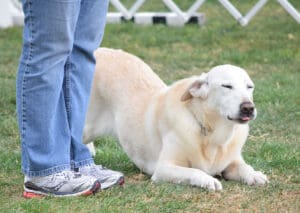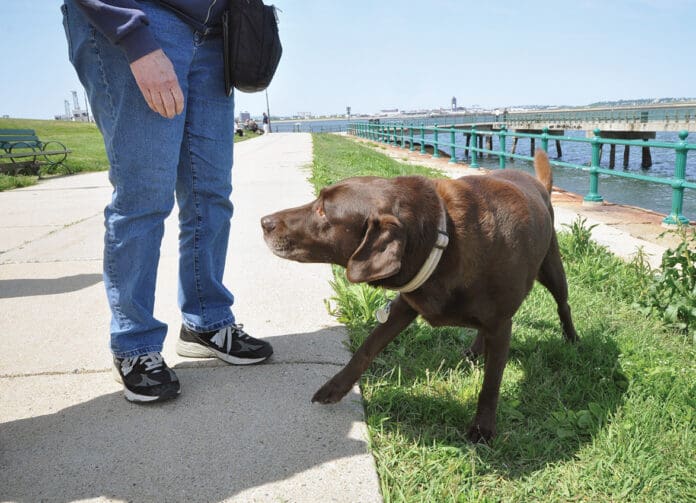When dog behavior doesn’t make sense to us, it’s easy to just shrug and say our dogs are stubborn or crazy. But often a productive answer is right there in front of us, if only we’re willing to look at dog body language—and our own.
The way we humans move matters. For example, do you stand tall and walk toward your dog when you’re calling him? That may be why he doesn’t come to you. On Planet Dog, that direct-facing approach sends a message to stop or back up. (Much better to angle to the side and start moving back a bit as you call—that tells your dog to come along.)
But it’s not just our human movement that deserves attention. The subtleties of our dog’s movement matters, too. When you sit down next to your dog for a cuddle, does she look away or lean away? Does she yawn or lick her lips? If she does those things, but you continue petting her, you may have an answer for why she “doesn’t listen” to you in general: You’re not listening to her, either, so she feels a bit on her own.
Instead, when you see one of those signals, give your dog space. Back up a foot. Now does she come over for a snuggle? Great! If not, also great, because you listened to her, which will build some critical trust.
Pay Attention to Your Dog’s Body Language

Canids and primates use their bodies differently. Dr. Patricia McConnell’s classic book The Other End of the Leash powerfully illustrates how that’s at the root of an enormous amount of dog-human misunderstanding. Many of the issues that send people to dog trainers—and eventually veterinary behaviorists, as things escalate—stem from our human lack of attention to body language. It’s also the hidden cause of the confusion and disappointment that runs through countless dog-human relationships.
“We humans are talking . . . but our dogs are watching,” Dr. McConnell writes. “Once you learn to focus on the visual signals between you and your dog, the impact of even tiny movements will become overwhelmingly obvious.”
For example, let’s say there’s a new dog you’re hoping to befriend. In your human (primate) style, you’re inclined to move in close, get face-to-face, reach out and even hug, just like chimps and bonobos would. But when dogs (or wolves and coyotes) have a friendly intent, they would not do any of those things. Oops. No wonder the dog ducks away, backs up, or even growls if he doesn’t have the ability to retreat.
Let’s say you knew enough to approach that dog in a more canine way; you start by giving the dog some space, angle slightly to the side, crouch, and glance away. McConnell notes that a human leaning in just half an inch makes a dog move away, where leaning back just slightly works as an invitation. The difference of an inch is dramatic in terms of building a relationship!
Does Your Dog Really Feel Safe With You?
Given how important body language is, why is it that beginner dog training classes never seem to spend any time on it? I suspect the answer is that we humans are in a rush to learn something that feels “real” and seems obviously helpful, like sit or stay.
Well, ask any veterinary behaviorist who’s counseled folks after dog bites, and they’ll tell you learning two-way body language is plenty useful and frankly a lot more important than “heel.”
Your skill in this area determines whether your dog feels safe with you and whether you’re able to assess when your dog feels uncomfortable.
It typically doesn’t even cross our minds that our dogs don’t feel safe. After all, we know they’re safe! But being safe and feeling safe are two very different things, and if an animal (humans included) doesn’t have “felt safety” it can affect an enormous range of behaviors. Dogs who feel safer become less skittish, obviously—but also less barky, less jumpy, more able to settle, and more attentive because they trust that listening to humans will work out well for them.
This is where the importance of body language comes in: Our body movement can either make our dogs feel safer or less safe. And our attention to their body language can either make them feel safer or less safe. It’s not an exaggeration to say that getting this right will transform your relationship with your dog.
Give Your Dog Choices
For me, Body Language Lesson #1 is teaching humans to get in the habit of giving their dog agency, the ability to choose. By being intentional with our own body movement, we can offer the relationship-building gift of distance. We can train ourselves to stop a foot or two away and invite the interaction rather than forcing it. We can stop the striding in with big footsteps and a direct approach. We can stop looming, cornering our dogs in small spaces, and swooping in to pick them up and hold them prisoner. In short, we can stop smothering them with our primate displays of affection.
If that key lesson is absorbed, it becomes a little less important to become an immediate expert at what is a trickier subject: truly reading your own dog’s body language. Almost everyone can see that a dog who’s running away, pulling away, or shaking is afraid. But sometimes we need a trainer to teach us how to look for loose, relaxed body language versus a stiff, still posture that signals uneasiness. There is much more to learn to recognize in time—tucked tails, lip-licking, rolling over, the lifting of one paw, a whale eye, etc.—but giving space and agency is an immediate game-changer.
Think Playing “Charades” With Your Dog
While most of the critical body-language-reading moments of the day do not happen during a training session—bites happen at Thanksgiving, not during training! —casual daily at-home sessions are incredibly helpful. Frequent practice in a predictable, rewarding situation will smooth the communication path between you and your dog. I encourage folks to make a daily habit of a handful of relaxed, fun, two-minute lessons. Teach easy, low-pressure stuff, such as touch and spin. By working on these things that “don’t matter,” you’ll be building your fluency together, which is the whole ballgame.
Have you ever played the game charades? When you’re trying to get better at body language, I think it’s helpful to use that game’s mindset as you train. The skills it takes to win at charades are 100% relevant to the skills it takes to build solid two-way communication with your dog:
- Think through what you’re going to communicate beforehand.
- Keep it simple or you’ll throw your teammate off.
- No extraneous body movements or you could get onto a tangent you can’t get back from.
- Clear your mind as you’re trying to decipher their clues, because your own thoughts will take you down the wrong road.
- Give your full attention to your partner.
- Understand that each round is half their job, but also half your job.
Your dog has actually been trying to play charades with you forever! He’s been watching your every move, trying to assess its meaning, and hoping you’ll respond to the clues he offers. Imagine his delight when he finds his teammate is suddenly coming to practice and engaged in the game! You’ll both end up enjoying the prize, which is a deepening interspecies friendship filled with trust and understanding.








Enjoying relearning things I’d forgotten and adding new information.